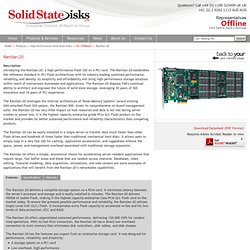

Content-addressable memory. Content-addressable memory (CAM) is a special type of computer memory used in certain very high speed searching applications.

It is also known as associative memory, associative storage, or associative array, although the last term is more often used for a programming data structure.[1] It compares input search data (tag) against a table of stored data, and returns the address of matching data (or in the case of associative memory, the matching data).[2] Several custom computers, like the Goodyear STARAN, were built to implement CAM, and were designated associative computers.
Hardware associative array[edit] Optical disc. The bottom surface of a compact disc, showing characteristic iridescence.

Optical discs are usually between 7.6 and 30 cm (3 to 12 in) in diameter, with 12 cm (4.75 in) being the most common size. A typical disc is about 1.2 mm (0.05 in) thick, while the track pitch (distance from the center of one track to the center of the next) is typically 1.6 µm. An optical disc is designed to support one of three recording types: read-only (e.g.: CD and CD-ROM), recordable (write-once, e.g.
CD-R), or re-recordable (rewritable, e.g. CD-RW). Optical discs are most commonly used for storing music (e.g. for use in a CD player), video (e.g. for use in a Blu-ray player), or data and programs for personal computers (PC). For computer data backup and physical data transfer, optical discs such as CDs and DVDs are gradually being replaced with faster, smaller solid-state devices, especially the USB flash drive. History[edit] Solid-state drive.
DDR SDRAM based SSD. Max 128 GB and 3072 MB/s. PCIe, DRAM and NAND-based SSD. It uses an external power supply to make the DRAM non-volatile. As of 2010[update], most SSDs use NAND-based flash memory, which retains data without power. For applications requiring fast access, but not necessarily data persistence after power loss, SSDs may be constructed from random-access memory (RAM). Hybrid drives or solid state hybrid drives (SSHD) combine the features of SSDs and HDDs in the same unit, containing a large hard disk drive and an SSD cache to improve performance of frequently accessed data.[9][10][11] PCI STORAGE - RamSan-20. The RamSan-20 delivers a complete storage system on a PCIe card.

It minimizes latency between the server’s processor and storage and is easily installed in minutes. The RamSan-20 delivers 450GB of usable Flash, making it the highest capacity enterprise class PCIe SLC Flash card on the market today. To ensure the greatest possible performance and reliability, the RamSan-20 utilizes Single Level Cell (SLC) Flash. It incorporates extra Flash capacity to accelerate writes and for two levels of data protection, ECC and RAID. The RamSan-20 offers unparalleled sustained performance, delivering 120,000 IOPS for random read operations. The RamSan-20 has the features you expect from an enterprise storage card. Texas Memory Systems: RamSan-440. Rackmount SSDs vendors on StorageSearch.com. DCIG ranks top rackmount SSD vendors Editor:- March 31, 2014 - If you're interested in rackmount SSDs then DCIG has published the DCIG 2014-15 Flash Memory Storage Array Buyer's Guide (free sign-up page) - which provides detailed comments on the strengths and weaknesses of rackmount SSD systems from 20 different vendors - which are currently available in the market today (includes list prices).

DCIG have created their own multi-dimensional scoring system in which they look at component features such as density (TB/U), software compatibility (for example ease of integration with VMware), and management functions (dedupe, tiering, snapshots etc). DCIG has ranked these systems overall - and compared many of them to others in the same price band. Another useful feature of the report is a background story about the design heritage or market history of each product. As to the product rankings? Lists the top 20 SSD companies - Jan 2011 edition. New edition!

- series overview and links to all past quarterly editions by Zsolt Kerekes, editor, StorageSearch.com - January 31, 2014 Who are the top SSD companies?... The companies which you absolutely have to look at if you've got any new projects involving SSDs? There are over 500 companies actively designing and marketing SSD products and systems today. About 7 years ago I started publishing a new series - the Top SSD Companies which has been seen by over 5 million readers and is now regarded by many key people in the SSD industry (and their investors and biggest customers) as one of the most useful SSD articles which influences their thinking. In the very 1st edition (July 2007) I explained why I believed search volume based data would be the best way to shortlist the future winners in the SSD market. I'm a heavy user of the list myself - because it reminds me what you think is important.